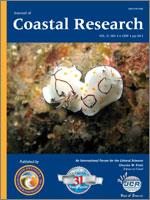Chao, M.; Shi, Y.; Quan, W., and Shen, X., 2015. Distribution of macrocrustaceans in relation to abiotic and biotic variables across the Yangtze River Estuary, China
In this article, we report on a study of the spatial and seasonal distribution of macrocrustaceans and reveal the correlation between macrocrustacean community and environmental variables in the Yangtze River Estuary, China. A total of 44 species belonging to 21 families were identified during sample collection in May, August, and November 2010 and February 2011. Species richness of four survey trips showed significant differences among seasons and zones. The most frequent species identified were Neoeriocheir leptognathus (M.J. Rathbun, 1913) in February and May; Palaemon gravieri (Yu, 1930) in August; and Exopalaemon annandalei (Kemp, 1917) in November. The mean macrocrustacean abundance in May 2010, August 2010, November 2010, and February 2011 was 24.94, 19.82, 29.46, and 17.14 individuals/1000 m2, respectively. The distribution of macrocrustaceans demonstrated a significant variation among seasons and zones based on PERMANOVA analysis. In terms of the value of species dominance, P. gravieri was the most dominant species throughout the study period, which composed 27.4% of the total specimens obtained. The distribution of macrocrustacean abundance in relation to biotic and abiotic variables was studied by multivariate analysis of macrocrustaceans using cluster and canonical correspondence analyses. These results demonstrated three typical classifications of communities and a significant relationship between macrocrustaceans and environmental variables. Salinity was the determining factor for spatial distribution of species and temperature for species occurrence on the entire estuarine scale. Additionally, biotic variables such as abundance of Polychaeta, abundance of primary production, and abundance of estuarine resident fishes also found significant variables that correlated with the abundance of macrocrustaceans in the Yangtze River Estuary. The study on relationship between macrocrustaceans and environmental variables provided baseline information for future ecological risk assessment in the Yangtze River estuary.





